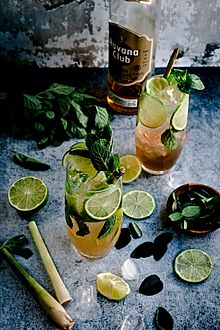Mojito facts for kids
| IBA official cocktail | |
|---|---|
 |
|
| Type | Cocktail |
| Primary alcohol by volume | |
| Served | On the rocks; poured over ice |
| Standard garnish | sprigs of mint and slice of lime |
| Standard drinkware | Collins glass |
| IBA specified ingredients |
|
| Preparation | Mix mint sprigs with sugar and lime juice. Add splash of soda water and fill the glass with ice |
A Mojito (pronounced moe-HEE-toe) is a classic drink that comes from Havana, Cuba. It's known for being very refreshing, especially in warm weather. This popular drink usually has five main ingredients: a clear type of rum, sugar, fresh lime juice, soda water, and mint. The mix of sweet, citrus, and fresh mint flavors makes it a favorite summer drink around the world.
To make a Mojito, you first mix fresh lime juice with sugar and mint leaves. This mixture is then gently pressed with a tool called a muddler. It's important to only bruise the mint leaves slightly. This helps them release their natural oils without tearing them apart. Next, rum is added, and the mix is stirred briefly. This helps the sugar dissolve and lifts the mint leaves for a nice look. Finally, the glass is filled with crushed ice and topped with sparkling soda water. People often decorate the drink with fresh mint leaves and lime wedges.
The History of the Mojito
The Mojito was created in Havana, Cuba, but its exact beginning is a bit of a mystery. Some stories say it started a long time ago. Local people in Cuba knew how to use plants to make medicines. A group of explorers once landed in Cuba and learned about a drink that could help with tropical illnesses. This drink was made from a strong spirit from sugar cane, mixed with lime, sugar cane juice, and mint.
Lime juice was very important because it helped prevent diseases like scurvy. Mint, lime, and sugar also helped to make the strong spirit taste better. Another idea is that the famous explorer Sir Francis Drake might have helped create an early version of this drink. His drink, called "El Draque," used similar ingredients but with brandy.
Some historians believe that African slaves who worked in Cuban sugar cane fields in the 1800s played a part in the drink's history. They often drank guarapo, which is juice from sugar cane. This drink was popular among them and is sometimes used in Mojitos today.
How the Mojito Got Its Name
There are a few ideas about where the name Mojito came from. One idea is that it's related to "mojo," which is a Cuban sauce made with lime. This sauce is used to add flavor to food. Another idea is that the name Mojito comes from the Spanish word mojadito. This word means "a little wet" and is a smaller version of mojado, which means "wet."
The famous writer Ernest Hemingway is often said to have loved Mojitos. Many people believe he made a bar called La Bodeguita del Medio famous. He supposedly wrote on the bar's wall, "My mojito in La Bodeguita, My daiquiri in El Floridita." Even though some people doubt if he really said this, the story has made the bar very well-known.
In 2016, a study found that the Mojito was the most popular drink in Britain and France.
Different Kinds of Mojitos
Many places like hotels in Havana sometimes add a few drops of Angostura bitters to their Mojitos. This helps to balance the sweetness. Instead of regular sugar, some people use Powdered sugar because it dissolves more easily. Many places also use simple syrup instead of sugar.
There are many fun ways to change a Mojito:
- A "Rose Mojito" has a rose-flavored spirit called Lanique.
- A "Virgin Mojito" or "Nojito" is a Mojito made without any alcohol. This is a great choice for kids!
- The Cojito adds a coconut flavor, often by using coconut-flavored rum.
- A "dirty mojito" uses a darker rum instead of white rum. It also uses raw sugar, which gives it a caramel-like taste.
- A "dark rum mojito" simply uses dark rum instead of white rum.
In Mexico, some people make a "Mojito Blanco" by using tequila instead of rum.
In Peru, you can find Mojitos with added fruits like grapefruit, called "Mojito de toronja," or passionfruit, called "Mojito de maracuyá." Other fruits like pears, raspberries, and oranges are also sometimes added to Mojito recipes. Sometimes, fruit purees are used instead of whole fruits. A strawberry mojito includes mashed strawberries.
See also
 In Spanish: Mojito para niños
In Spanish: Mojito para niños

